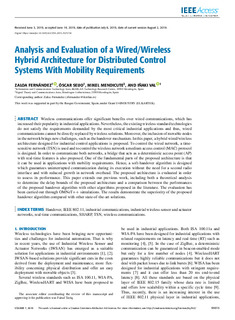| dc.rights.license | Attribution 4.0 International | * |
| dc.contributor.author | Mendicute, Mikel | |
| dc.contributor.other | Fernández Ganzabal, Zaloa | |
| dc.contributor.other | Seijo, Óscar | |
| dc.contributor.other | Val, Iñaki | |
| dc.date.accessioned | 2020-03-31T15:05:12Z | |
| dc.date.available | 2020-03-31T15:05:12Z | |
| dc.date.issued | 2019 | |
| dc.identifier.issn | 2169-3536 online | en |
| dc.identifier.other | https://katalogoa.mondragon.edu/janium-bin/janium_login_opac.pl?find&ficha_no=152719 | en |
| dc.identifier.uri | https://hdl.handle.net/20.500.11984/1612 | |
| dc.description.abstract | Wireless communications offer significant benefits over wired communications, which has increased their popularity in industrial applications. Nevertheless, the existing wireless standard technologies do not satisfy the requirements demanded by the most critical industrial applications and thus, wired communications cannot be directly replaced by wireless solutions. Moreover, the inclusion of movable nodes in the network brings new challenges, such as the handover mechanism. In this paper, a hybrid wired/wireless architecture designed for industrial control applications is proposed. To control the wired network, a time-sensitive network (TSN) is used and to control the wireless network a medium access control (MAC) protocol is designed. In order to communicate both networks, a bridge that acts as a deterministic access point (AP) with real-time features is also proposed. One of the fundamental parts of the proposed architecture is that it can be used in applications with mobility requirements. Hence, a soft-handover algorithm is designed which guarantees uninterrupted communication during its execution without the need for a second radio interface and with reduced growth in network overhead. The proposed architecture is evaluated in order to assess its performance. This paper extends our previous work, including both a theoretical analysis to determine the delay bounds of the proposed architecture and a comparison between the performances of the proposed handover algorithm with other algorithms proposed in the literature. The evaluation has been carried out through OMNeT++ simulations. The results demonstrate the superiority of the proposed handover algorithm compared with other state-of-the-art solutions. | en |
| dc.description.sponsorship | Gobierno Vasco | es |
| dc.language.iso | eng | en |
| dc.publisher | IEEE | en |
| dc.rights | © Los autores | en |
| dc.rights.uri | http://creativecommons.org/licenses/by/4.0/ | * |
| dc.title | Analysis and Evaluation of a Wired/Wireless Hybrid Architecture for Distributed Control Systems With Mobility Requirements | en |
| dcterms.accessRights | http://purl.org/coar/access_right/c_abf2 | en |
| dcterms.source | IEEE Access | en |
| local.contributor.group | Teoría de la señal y comunicaciones | es |
| local.description.peerreviewed | true | en |
| local.description.publicationfirstpage | 95915 | en |
| local.description.publicationlastpage | 95931 | en |
| local.identifier.doi | http://dx.doi.org/10.1109/ACCESS.2019.2927298 | en |
| local.relation.projectID | GV/Elkartek 2019/KK-2019-00101/Microsistemas inteligentes avanzados e integrados en la industria. Monitorización, digitalización e inspección preventiva en entornos de producción/µ4INDUST | en |
| local.rights.publicationfee | APC | en |
| local.rights.publicationfeeamount | 1700 USD | en |
| local.contributor.otherinstitution | https://ror.org/03hp1m080 | es |
| local.source.details | Vol. 7. Pp. 95915-95931, 2019 | eu_ES |
| oaire.format.mimetype | application/pdf | |
| oaire.file | $DSPACE\assetstore | |
| oaire.resourceType | http://purl.org/coar/resource_type/c_6501 | en |
| oaire.version | http://purl.org/coar/version/c_970fb48d4fbd8a85 | en |








